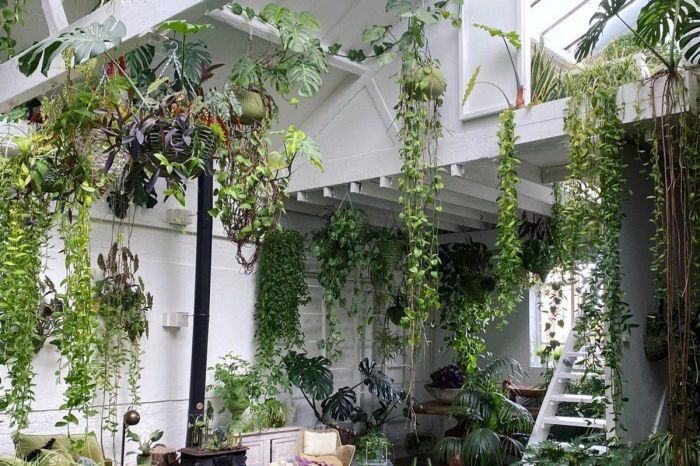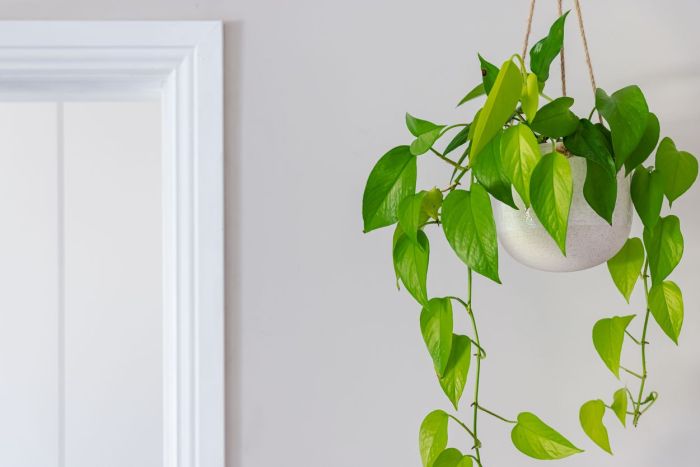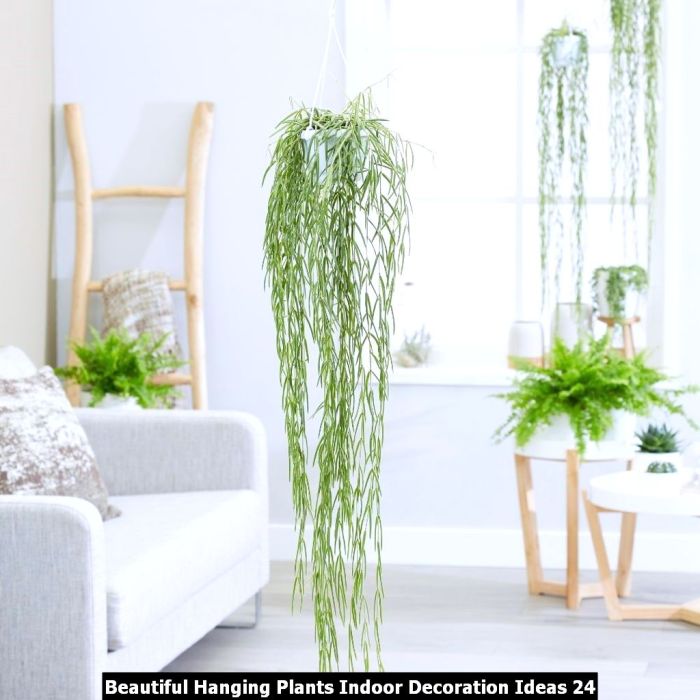Incorporating real indoor hanging plants into your living environment offers a myriad of benefits, from purifying the air to reducing stress levels. This comprehensive guide delves into the world of indoor hanging plants, providing expert advice on selecting the right species, troubleshooting common problems, and maximizing their aesthetic appeal.
Discover the diverse range of indoor hanging plants, each with its unique characteristics and care requirements. Learn how to choose the perfect plants for your space, considering factors such as natural light availability, room size, and personal style. Embrace creative display ideas to showcase your hanging plants as stunning focal points, adding height and depth to your interiors.
Popular Indoor Hanging Plant Species
Hanging plants add a touch of greenery and life to any indoor space. They can purify the air, improve mood, and create a sense of peace and tranquility. There are many different types of hanging plants to choose from, each with its own unique look and care requirements.
For real indoor hanging plants to thrive, sufficient lighting is crucial. Wall Mounted Plant Grow Lights: Enhancing Indoor Greenery with Precision offer a targeted solution, delivering the necessary spectrum and intensity of light to promote healthy growth and lush foliage, enhancing the aesthetic appeal of any indoor space.
Some of the most popular indoor hanging plant species include:
Spider Plant
- Spider plants are one of the most popular indoor hanging plants because they are easy to care for and can tolerate a wide range of conditions.
- They have long, slender leaves that are variegated with white or cream stripes.
- Spider plants produce small, white flowers that bloom in the spring and summer.
- They prefer bright, indirect light and should be watered when the soil is dry to the touch.
Pothos
- Pothos is another popular indoor hanging plant that is easy to care for.
- It has heart-shaped leaves that are variegated with green, white, or yellow.
- Pothos can tolerate low light conditions and should be watered when the soil is dry to the touch.
String of Pearls
- String of pearls is a unique and beautiful indoor hanging plant that has long, trailing stems covered in small, round leaves that resemble pearls.
- It prefers bright, indirect light and should be watered when the soil is dry to the touch.
Burro’s Tail
- Burro’s tail is a succulent hanging plant that has long, trailing stems covered in plump, cylindrical leaves.
- It prefers bright, indirect light and should be watered sparingly, allowing the soil to dry out completely between waterings.
Air Plants
- Air plants are unique in that they do not need to be planted in soil.
- They absorb nutrients and moisture from the air through their leaves.
- Air plants prefer bright, indirect light and should be misted with water every few days.
Benefits of Indoor Hanging Plants

Indoor hanging plants are not only aesthetically pleasing but also offer a range of benefits that contribute to the health and well-being of individuals. Their presence in indoor spaces has been linked to improved air quality, reduced stress levels, and enhanced cognitive function.Hanging
plants act as natural air purifiers, removing harmful pollutants and toxins from the air. Studies have shown that certain species, such as the spider plant and peace lily, can effectively reduce levels of benzene, formaldehyde, and trichloroethylene, which are commonly found in household products and building materials.
By improving air quality, hanging plants create a healthier indoor environment, reducing the risk of respiratory issues and allergies.The presence of hanging plants has also been shown to reduce stress and promote relaxation. Their lush greenery and vibrant colors can create a calming and serene atmosphere, providing a respite from the hustle and bustle of daily life.
Studies have found that individuals exposed to indoor plants experience lower levels of cortisol, a hormone associated with stress, and increased feelings of calmness and tranquility.Furthermore, incorporating hanging plants into indoor spaces can enhance cognitive function and productivity. Research has shown that exposure to plants can improve concentration, attention span, and memory.
Real indoor hanging plants not only add a touch of nature to your home but also purify the air and boost your mood. To enhance the aesthetics and functionality of your indoor space, consider using Metal Hanging Planters for Indoor Spaces . These planters are durable, stylish, and provide excellent support for your real indoor hanging plants, creating a lush and inviting atmosphere in your home.
The natural beauty and calming effects of hanging plants can create a more stimulating and conducive environment for work and study.
Real indoor hanging plants add a touch of nature and elegance to any space. To enhance their aesthetic appeal and functionality, consider using Amazon Plant Hangers Indoor . These stylish and durable hangers elevate your greenery, showcasing its beauty while optimizing space.
By suspending plants from the ceiling or walls, you create a lush vertical garden that transforms any room into a tranquil oasis.
Choosing the Right Hanging Plants for Your Space

When selecting hanging plants for your indoor space, consider factors such as natural light availability, room size, and decor style. Choose plants that complement your existing furniture and color scheme, and research their growth habits and maintenance requirements to ensure they thrive in your environment.
Plant Size and Room Dimensions
- Consider the size of the room and the hanging space available. Larger plants suit spacious rooms, while smaller plants are ideal for compact areas.
- Ensure the plant’s trailing length complements the room’s height and furniture arrangement.
Light Requirements
- Determine the amount of natural light your space receives. Choose plants suited to the light conditions, such as low-light tolerant plants for dimly lit areas or sun-loving plants for well-lit spaces.
- Consider using grow lights to supplement natural light for plants that require brighter conditions.
Decor Style and Color Scheme
- Select plants that complement your decor style, whether it’s modern, bohemian, or traditional.
- Choose plants with foliage or flowers that match or contrast with your existing color scheme, adding visual interest and harmony.
Growth Habits and Maintenance
- Research the growth habits of different hanging plants to ensure they are suitable for your space and lifestyle.
- Consider factors such as watering frequency, pruning requirements, and potential pests or diseases.
Creative Display Ideas for Indoor Hanging Plants
Incorporating hanging plants into your indoor space can add a touch of greenery and create a lush, inviting atmosphere. To maximize their aesthetic appeal and functionality, consider these creative display ideas:
Macrame Hangers
Macrame hangers are a stylish and versatile way to suspend plants from the ceiling or walls. Their intricate knots and patterns add a bohemian touch to any room, and they come in various sizes and colors to match your décor.
Wall-Mounted Planters
Wall-mounted planters are a space-saving solution for displaying hanging plants. They can be arranged in clusters or staggered at different heights to create a focal point or add vertical interest to a wall.
Ceiling Hooks
Ceiling hooks are a simple and effective way to hang plants from the ceiling. They allow you to adjust the height and position of your plants easily, making them ideal for creating a cascading effect or adding height to a room.
Dividing a Space
Hanging plants can also be used to divide a space without creating a physical barrier. Suspending plants from the ceiling or installing wall-mounted planters can help delineate different areas of a room, such as a living area from a dining area.
Troubleshooting Common Problems with Indoor Hanging Plants
Indoor hanging plants add beauty and vitality to any space, but they can sometimes encounter problems. By identifying and addressing these issues promptly, you can keep your plants healthy and thriving.
Real indoor hanging plants can bring life and beauty to any space. From cascading ferns to trailing ivy, there are countless options to choose from. For more information on the best hanging plants for your home, visit Hanging Plants . With proper care, real indoor hanging plants can thrive and add a touch of nature to your living space.
Yellowing Leaves, Real indoor hanging plants
Yellowing leaves can indicate several underlying problems:
- Overwatering:Check the soil moisture level and reduce watering frequency if the soil is soggy.
- Underwatering:Ensure the soil is moist but not waterlogged. Water thoroughly when the top inch of soil feels dry.
- Nutrient deficiency:Fertilize the plant according to the recommended schedule for its species.
- Sunlight exposure:Ensure the plant is receiving the appropriate amount of sunlight for its species.
Pests
Common pests that affect indoor hanging plants include aphids, spider mites, and mealybugs. To control pests:
- Physical removal:Manually remove visible pests using a damp cloth or insecticidal soap.
- Chemical treatment:Apply a horticulture oil or insecticidal soap specifically formulated for indoor plants.
- Biological control:Introduce natural predators such as ladybugs or lacewings to control pest populations.
Overwatering
Overwatering is a common problem that can lead to root rot. To prevent overwatering:
- Check soil moisture:Use a moisture meter or finger to check the soil moisture level before watering.
- Use well-draining soil:Ensure the potting mix has good drainage to prevent waterlogging.
- Water only when necessary:Allow the top inch of soil to dry out before watering.
Closing Summary

Whether you’re a seasoned plant enthusiast or just starting your indoor gardening journey, this guide empowers you to create a thriving indoor oasis with real hanging plants. Embrace the beauty and benefits of nature within your own walls, transforming your space into a sanctuary of tranquility and well-being.
Q&A: Real Indoor Hanging Plants
What are the most popular indoor hanging plant species?
Common indoor hanging plant species include pothos, spider plants, philodendrons, ferns, and string of pearls.
How do I choose the right hanging plants for my space?
Consider the amount of natural light, room size, and overall decor style when selecting hanging plants.
What are some creative ways to display hanging plants?
Use macrame hangers, wall-mounted planters, or ceiling hooks to create unique and eye-catching displays.